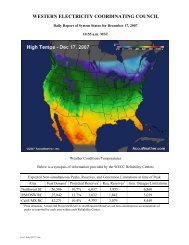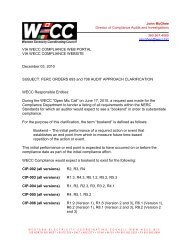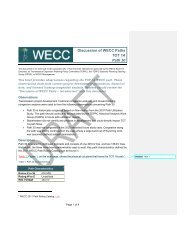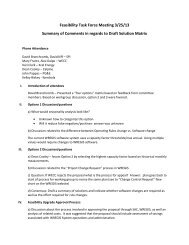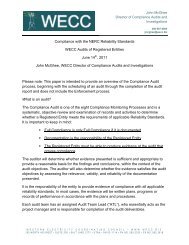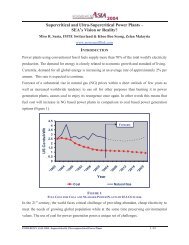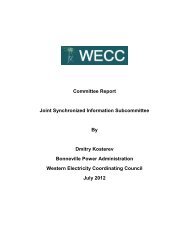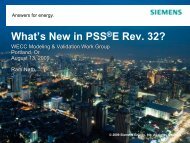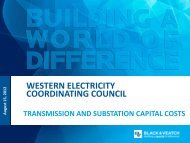E3_EDT_Phase2_Methodology_and_Sensitivities_2011-04-22
E3_EDT_Phase2_Methodology_and_Sensitivities_2011-04-22
E3_EDT_Phase2_Methodology_and_Sensitivities_2011-04-22
Create successful ePaper yourself
Turn your PDF publications into a flip-book with our unique Google optimized e-Paper software.
About <strong>E3</strong><strong>E3</strong>’s expertise has placed us at the nexus of planning,policy <strong>and</strong> markets in California <strong>and</strong> the WestRegulatory/PolicyEE avoided costs for CA utilitiesCalculate MPR for CPUC33% RPS <strong>and</strong> GHG studies for CPUCAdvising CPUC on long-term planningCA Solar Initiative cost-effectivenessEPA National Action Plan for efficiency2007 Idaho Energy PlanUtilityRTO West market designWEIL Group “Towards 2020” studyBC-California renewable energy partnershipExpert testimony for CAISO on Sunrise lineCapital cost model for TEPPCHPX commercial feasibility studyWECC SPSG technical supportCleantech/Emerging TechnologiesAnalysis of market opportunities for emerging technologies such as renewables,distributed generation, dem<strong>and</strong> response, smart grid, energy storage, electric vehiclesClients include EPRI, BrightSource Energy, First Solar, Hydrogen Energy International, VCclients5
Section 2: Phase 2 Study<strong>Methodology</strong>
Phase 2 Overview & MotivationOverall Goal: Estimate the societal benefits of implementingan EIM throughout the West (excluding CAISO <strong>and</strong> AESO)Phase 1 (completed):• Identified significant benefit to more coordinated operations bycomparing a scenario with existing operations to a consolidatedbalancing energy market across the West• Indicated those results are sensitive to zone definitions, reserveprocurement, <strong>and</strong> hydro assumptionsPhase 2 will seek to improve precision of EIM benefitestimation by:• Increasing zonal resolution• Improving quality of assumptions regarding reserve procurement &hydro under Benchmark & EIM Cases• Testing sensitivity to partial participation <strong>and</strong> other factors, as timepermits8
TimelinePhase 1 (Completed)1/11/11: Detailed Phase 1 Scope posted forcomment1/18/11: Stakeholder Workshop – Phase 11/25/11: Detailed Phase 1 Scope commentsdue2/1/11: Approve detail Phase 1 Scope(<strong>EDT</strong>TRS)2/21/11: Phase 1 Draft PPT report complete3/1/11: High-level Phase 2 issuesidentified (approval by <strong>EDT</strong>TRS)3/2/11: Phase 1 Final PPT report complete3/3/11: Present results to Joint St<strong>and</strong>ingCommittees3/16/11: Present Phase 1 Results to Boardof Directors4/10/11: Phase 1 Results technical memo(pending)Phase 24/1/11: Detailed Phase 2 Scopeposted for comment4/7/11: Stakeholder Workshop –Phase 24/13/11: Detailed Phase 2 Scopecomments due4/20/11: Approve detail Phase 2Scope (<strong>EDT</strong>TRS)6/1/11: Phase 2 Draft PPT reportcomplete6/10/11: Phase 2 Final PPT Reportcomplete6/20/11: Technical memo on Phase 2results to WECC6/21/11: Output files to WECC6/23/11: Present Results to BOD atAnnual Meeting9
Phase 2 CasesThe analysis will consist of developing <strong>and</strong>comparing the following cases:• Case P2-A: Updated 2006 Benchmark Case(for Hurdle rate calibration)• Case P2-B: Updated 2020 Benchmark Case• Case P2-C: Updated 2020 EIM Case• Case P2-D: Updated 2020 EIM Case with partialparticipation• Additional sensitivity cases as time permits10
Process for Creating Phase 2ModelsStart withPh.1 2006BenchmarkCaseDevelop hurdle ratesfor additionalinterface betweennew zonesRun Updated2006 BenchmarkCase (P2-A)Refine reserveprocurement &hydro assumptionsApply new hurdlerates to Ph.1 2020Benchmark Casewith more zonesRun Updated2020 BenchmarkCase (P2-B)Remove hurdle rates,use EIM reserveassumptions <strong>and</strong> run2020 EIM Case (P2-C)Remove selected hurdlerates, use partial EIMreserve assumptions <strong>and</strong>run Sensitivity Case(P2-D)11
Key Assumptions to Phase 2 CasesUpdated Assumption in Phase 2Cases1. Increase zonal granularity(24 zones with new hurdle ratesprimarilywithin Northwest <strong>and</strong> AZ, <strong>and</strong>inclusion of SMUD & LADWP)2. Modify conventional reserverequirement assumptions underBenchmark & EIM cases3. Implement flexibility reserverequirements that are met moreefficiently under EIM case4. Use day ahead forecast of windoutput for unit commitment cycle (Maybe as sensitivity case)5. Improve hydro modeling usinghydrothermal co-optimization (HTC)6. Maintain hurdle rates for unitcommitment cycle in EIM case (exceptfor Gas CTs)Intended to reflect:Greater base case friction totransactions without EIMNeed to procure regulationfrom local sourcesNeed for reserves to addressload <strong>and</strong> resource variability &uncertaintyDay-ahead uncertainty ofcertain resource outputPartial price responsiveness ofsome hydro resourcesPotential limited influence of 5-min real-time market on dayaheadcommitment decisionsApplies toCasesBenchmarkCases(P2-A, P2-B)All Phase 2casesAll Phase 2casesAll Phase 2casesAll Phase 2casesEIM Cases(P2-C, P2-D)12
1. Increased Zonal GranularityIncreasing the number of zones may result in a betterestimate of the potential benefits• Phase 1 (12 zones) may underestimate friction that exists intoday’s system• Limitations of modeling tools may prevent additional granularityfrom providing more accurate resultsCalibrating more hurdle rates will require additionaliterations & benchmarking• Not all zonal boundaries have readily available 2006 path flow data• For most new interfaces: will use posted OATT rates & losses unlessspecific data clearly indicate otherwiseReserve procurement zones will be treatedseparately13
1. Proposed 24 Zone Modelfor Phase 2NameDescription1 BC British Columbia2 AB Alberta3BPA BPA + SCL + TWPR + GCPD+ CHPD + DOPD4 NWE Northwestern Energy + WAUW5 NNV Sierra Pacific Power6 PACE PacifiCorp East7 WACM WAPA Rocky Mts.8 PSCO Xcel Colorado9 CA CAISO + CFE10 NEVP NV Energy11 AZPS APS12 NM New Mexico13 PSE Puget Sound Energy14 AVA Avista15 PGN Portl<strong>and</strong> General Electric16 PACW PacifiCorp West17 IPC Idaho Power18 WALC WAPA Lower Colorado19 SRP Salt River Project20 TEP Tucson Electric Power21 BANC BA of N. CA+ Turlock ID<strong>22</strong> EPE El Paso Electric23 LADWP LA Dept. of Water & Power24 IID Imperial Irrigation DistrictZone 13Zone 14Zone 15Zone 16Zone 1 Zone 2Zone 3Zone 5Zone 21Zone 9Zone 10Zone 23Zone 18Zone 24Zone 11Zone 17Zone 4Zone 6 Zone 7Zone12Zone 19 Zone 20Zone8Zone<strong>22</strong>1412
1. Zonal Granularity & UpdatedHurdle RatesPhase 1 hurdle rates:Simulated North-to South <strong>and</strong>East-to-West flows on east sideof system still higher than 2006actual flowsFor Phase 2:Will explore increasing East sidehurdle rates by approximately$6-10/MWh to more accuratelysimulate greater friction in thatpart of systemPhase 1 East-Side Benchmarked FlowsPath Flows (MW)Path Flows (MW)2006 Actual FlowsGridview Simulation Flows2,5002,0001,5001,00050002,0001,5001,000500P19: BRIDGER WEST (E-W)0JanFebMarAprMayJunJulAugSepOctNovDecP36: TOT 3 (N-S)JanFebMarAprMayJunJulAugSepOctNovDecPath Flows (MW)1,0005000-500-1,000P31: TOT 2A (N-S)JanFebMarAprMayJunJulAugSepOctNovDec15
2. Modified conventional reserverequirement assumptionsCaseTEPPC PC0ReserveProcurementRequirement4% of weeklypeak load*<strong>E3</strong> Phase 1 4% of hourly load*<strong>E3</strong> Phase 26% of hourly load*Geography of generationthat can meet reserve needsWithin local 7 TEPPC Regions (e.g., Basin,Southwest, etc.)Benchmark Case: Within local 12 ZonesEIM Case: Throughout in EIM footprintBenchmark & EIM Case: Fixed split(75/25%) between local 24 Zones <strong>and</strong> 6reserve procurement area*Note: Generator ramp rate constraints enforced in all cases for reserve needs.Simulation holds regulation <strong>and</strong> contingency reserves requirements even in dispatch.Phase 1: EIM case produced savings from optimized procurementof operating reserves within EIM footprintPhase 2: Will require same procurement geography of regulation& contingency reserves in both benchmark <strong>and</strong> EIM casesWill address flexibility reserve requirements separately16
2. Proposed Phase 2 ReserveProcurement AreasNameDescription1 BC British Columbia2 Alberta Alberta3 Northwest BPA region plus MontanaIPC, PACE, SPP, BANC, TID4 Rockies WACM + PSCO5 California CAISO + CFE6 Southwest PNM, APS, TEP, SRP,WALC, NVP, IID, LADWPBenchmark Case & EIM Case:Conventional reserve procurement splitbetween Zone <strong>and</strong> Area level• 75% portion of conventional reserves procuredfrom resources physically located in Zone(reflects regulation)Zone Area 1 Zone Area 2Area 3Area 4• Can procure remaining 25% from resourcesphysically located within the broader ProcurementArea (reflects contingency reserve needs)• Will confirm percentage splits with additional BAsArea 5Area 6Flexibility reserves addressed separately1317
3. Flexibility Reserve Requirement forManaging Load <strong>and</strong> Resource VariabilityBy 2020: Increased penetration of Variable Generation (VG)will focus more attention on need for ramping capability• “Ramp”: The ability of the generation fleet to rapidly change its output inresponse to dispatch signals• Typically measured in MW/min (up or down)• BAAs may need new mechanisms to procure sufficient ramp“Flexibility reserves”: Generation capabilities procured <strong>and</strong> heldto provide ramp <strong>and</strong> accommodate VG-related operational needsAggregation of variability across zones: may reduce need forflexibility reserves & increase options for fulfillment• Diversity means that the combined ramp needs for the entire EIM footprint isless than the sum of the ramp needs of all individual BAs• Can draw from more generators in wider area to satisfy requirements• The mechanism for procuring flexibility reserves is not yet determined so impactof EIM on this need is uncertain18
3. Phase 2 Modeling of FlexibilityReserve RequirementsNREL assessing flexibility reserve needs to address houraheaduncertainty <strong>and</strong> variability of resources & loads• Benchmark Case: NREL to provide <strong>E3</strong> with hourly flexibilityreserve requirement (in MW) for each zone• EIM Case: NREL to provide hourly flexibility reserve requirement ofthe aggregated EIM footprint• Should reflect reduce needs due to diversityPhase 2 GridView Runs will use hourly flexibility reserverequirements will be used as constraint• Will result in more commitment <strong>and</strong> therefore higher costs &higher average heat rates• EIM case will assume flexibility reserves can be procured fromacross the EIM footprint• Will provide enhanced benefits due to EIM footprint’s deeperresource stack compared to each individual zone19
Summary of Phase 2 <strong>Methodology</strong>by Reserve TypeType ofReserveTraditionalRegulation +ContingencyMet LocallyContingencyProcured fromWider AareaFlexibilityReserve ProcurementRequirementBenchmark & EIM Case:Fixed 75% portion of 6%conventional reserverequirementBenchmark & EIM Case:Remaining 25% of 6%conventional reserverequirementBenchmark Case:NREL-provided Hourly MWneed for each of 24 zonesEIM Case: NREL-providedHourly MW need foraggregate EIM footprintGeography of generationthat can meet reserveneedsBenchmark & EIM Case:From within local 24 ZonesBenchmark & EIM Case:From within 7 Reserve ProcurementAreasBenchmark Case:From within local 24 zonesEIM Case: Throughout EIM footprint*Note: Generator ramp rate constraints enforced in all cases for reserve needs.Simulation holds fulfillment of reserves requirements in dispatch.20
4. Use day ahead forecast of windoutput for unit commitment cycleNREL data provides historical day-aheadforecasts of the actual 2006 wind profilesused for TEPPC• Phase 1 Gridview simulations: use perfect foresightto optimize day ahead unit commitmentPhase 2: Will explore impact of day-aheaduncertainty of wind output by committingunits based on day-ahead forecasts ofhistorical wind profiles• Potentially could result in wind curtailment(or load curtailment) in limited number of hoursif day-ahead forecast is too low (or too high)• May result in reduced efficiency in all cases• EIM case likely to respond more easily due todiversity <strong>and</strong> deeper resource stack• Approach not well tested, so may need to useas sensitivity case only21
5. Price-ResponsiveHydro Modeling (HTC)Phase 1: Gridview model was unable to simulateprice-responsive hydro• The flexible portion of hydro output shape was exogenouslydetermined using Partial Load Following (PLF)• Scaled hourly based on net load in generator’s zonePhase 2: ABB team is finalizing HydrothermalCo-optimization (HTC) module• At HTC reshapes a portion of hydro output based onhourly prices in model• Will allow hydro units to dispatch when marginalmarket prices are higher• Used at approx. 40 plants in NW <strong>and</strong> California(as indentified by TEPPC)Expected Effect:• HTC-dispatched Hydro generation will to displace morecostly gas resources in hours of high system need• Lower total system production costs & greater efficiency<strong>22</strong>
6. Reduced Unit CommitmentOptimization in EIM5-min real-time EIM may not permit fully-optimized dayahead unit commitment decisionsPhase 2: will constrain unit commitment using twoconsecutive GridView runs (for all but Gas CTs)First Run Second Run EffectUse hurdle ratesin establishinghourly unitcommitmentdecisions for eachdayKeep commitmentfixed from the firstrun (for all resourcesexcept gas CTs)• Hourly commitment decisionfrom first run introduced asbinary input to second run• Prevents GridView fromaltering commitment decisionin EIM caseAssumes market participants do not use any informationfrom EIM in making their unit commitment decisions• Right answer is probably somewhere in the middle• Time permitting, could run sensitivity with modified assumptions23
Anticipated Impact of RevisedPhase 2 Assumptions on ResultsFactor1. Ph.2 Benchmark case will use hurdlerates between a 24 of smaller zones,rather than the 13 Ph. 1 zones.2. Ph.2 EIM Case will not allow full sharingof reserves across EIM footprint3. Ph.2 will add new flexibility reserverequirements by BA to meet changingrenewable generation <strong>and</strong> loads, <strong>and</strong> willallow EIM-wide sharing to satisfy needs.4. Ph.2 will seek to use day ahead forecastof wind generation in unit commitmentcycle to account for effect of uncertainty5. Ph.2 will seek to use HTC-based hydrodispatch but will not change PLF to followEIM-wide footprint6. Ph.2 will not change hurdle rates in unitcommitment cycle of EIM case, onlydispatch (except for Gas CTs)Impacton EIMBenefitsPositiveMediumNegativeHighPositiveMediumPositiveLowPositiveLowNegativeLowDiscussionMore hurdle rates betweenzones will reflect more basecase friction which EIM couldaddressFewer savings from reducedunit commitment & startupEIM will allow for lower totalflexibility reserve needs,partially offsetting reservesharing issue in row aboveMay cause potential loadcurtailment & EIMimprovementHydro will become partiallyprice responsive, <strong>and</strong> mayreshape based on EIM pricesAdditional generators will notcommit for export under EIM24
Phase 2 Simulation OutputsOutput to be provided• Full Gridview database for case simulations• Spreadsheet results of unit-specific hourly output data, nodalmarginal pricing• Production costs• Zonal flows• Spilled resourcesAfter simulation runs: could estimatecost of renewable resource curtailment• MWh of spilled resources in simulation* $/MWh proxy estimate of net value of lost renewable energy25
Section 3: Phase 2 StudyProposed Sensitivity Cases
Voluntary Participation SensitivityCases (by BA or Generator)Current benefits assume participation by all BAs outsideof California <strong>and</strong> Alberta• BPA <strong>and</strong> WAPA may have statutory restrictions to their participation• Phase 2 will run sensitivity case with BPA, WAPA out to estimatechange in the total benefits• Case will maintain hurdle rates & local flexibility reserve fulfillmentfor these BAs <strong>and</strong> zones embedded inside themCurrent benefits also assume all resources within eachBAA participate in voluntary market• As time permits, may attempt to test the sensitivity to thisassumption by assuming only a fraction of resources participate• E.g., assume only 50% of generators (r<strong>and</strong>omly selected) submitinc/dec bids• This case partially could test take or pay27
Additional Sensitivity AnalysisAs time permits, project team will also seek to runfive other sensitivity cases• Assignment of portion of Northwest flexibility reserverequirements to California(To reflect intra-hour scheduling & pseudoties)• CAISO market-to-market coordination (Reduced hurdlerates to/from CAISO during dispatch cycle only)• Low gas prices ($4/MMBtu average vs. $6-8 in base case)• High gas prices ($10/MMBtu)• CO 2 prices ($50/ton CO 2 vs. $0 in base case)28
Other Potential <strong>Sensitivities</strong>SuggestedAs time permits, we are considering additionalproposed sensitivity cases• Remove hurdle rates for all generators (not just gasCTs) in unit commitment cycle to simulate participantlearning <strong>and</strong> anticipation• Hydraulic model for dynamic hydro simulation on selectedplants• High/Low hydro availability sensitivity• Reduced BA participation beyond removal of BPA &WAPA29
Sensitive Case PrioritizationOrder Case Current Status123Reduced BA Participation in EIM(exclude BPA, BPA-embedded NW BAs, WAPA)Assign portion of NW hydro flexibility reserverequirement to CA(to address pseudo-tie/dynamic schedules)CAISO Market-to-Market Coordination(reduced EIM-CAISO hurdle rates)To be included.To run if time permits.To run if time permits.4-5 Low/High Gas Price Cases To run if time permits.6 CO2 Price Case To run if time permits.7 Reduced generator participation To run if time permits.89Remove hurdle rates on all gen in unitcommitment cycle (to simulate learning)Hydraulic Model for dynamic hydro (ifavailable)Proposed.Proposed.10-11 High/Low hydro availability sensitivity Proposed.12 Further Reductions in BA Participation Proposed.30
Thank you!
<strong>E3</strong> Contact InformationEnergy <strong>and</strong> Environmental Economics, Inc.101 Montgomery StSuite 1600San Francisco, CA 94117(415) 391-5100http://www.ethree.comRen Orans, Managing Partner (ren@ethree.com)Arne Olson, Partner (arne@ethree.com)Jack Moore, Senior Consultant (jack@ethree.com)32



